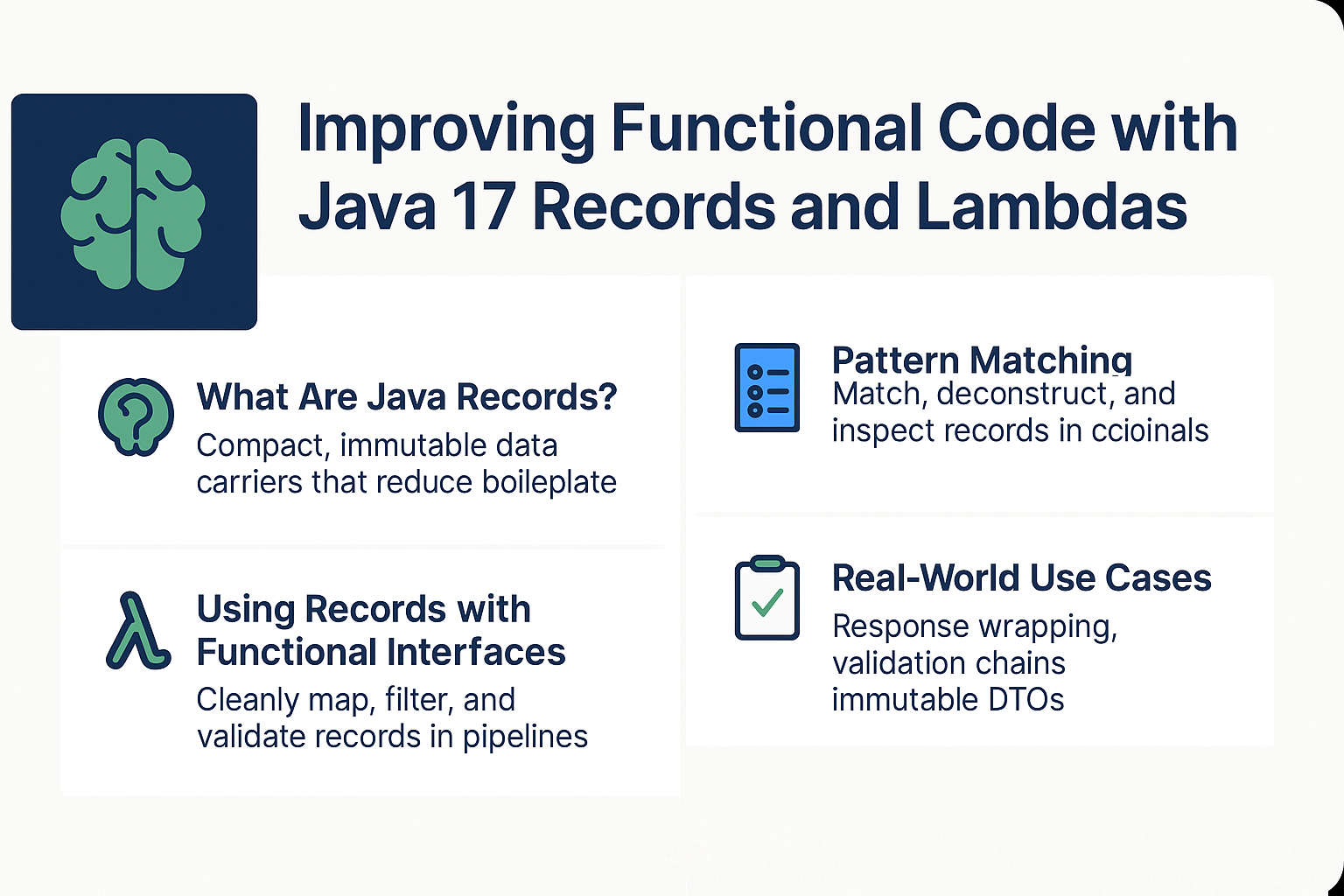Java 17 brings powerful features like records and enhanced pattern matching, which pair perfectly with lambdas to simplify data handling and make functional code more expressive.
In this tutorial, we explore how Java records reduce boilerplate and improve readability when used in functional pipelines, domain modeling, and business logic composition—especially when combined with lambdas and functional interfaces.
🧠 What Are Java Records?
Records are a special kind of class introduced in Java 14 (preview) and finalized in Java 16+. Java 17 is the first LTS version with stable record support.
A record is a compact, immutable data carrier.
public record User(String name, int age) {}
This is equivalent to writing a POJO with:
private finalfields- constructor
- getters
equals(),hashCode(),toString()
💡 Why Use Records in Functional Code?
Functional code often involves:
- Passing structured data through pipelines
- Mapping and transforming values
- Validating or filtering records
- Returning lightweight results from lambdas
Records simplify all of these with clean syntax, immutability, and automatic method generation.
🔧 Using Records with Functional Interfaces
Example: Filtering Records with Predicate
record Product(String name, double price) {}
Predicate<Product> isAffordable = p -> p.price() < 100;
List<Product> catalog = List.of(new Product("Pen", 5), new Product("Chair", 150));
catalog.stream()
.filter(isAffordable)
.forEach(System.out::println);
Mapping Records with Function<T, R>
record User(String name, String email) {}
record UserDto(String name) {}
Function<User, UserDto> toDto = user -> new UserDto(user.name());
List<UserDto> dtos = users.stream().map(toDto).toList();
Pattern Matching (Preview in Java 17)
static void printUser(Object obj) {
if (obj instanceof User(String name, int age)) {
System.out.println("User " + name + " is " + age);
}
}
🧰 Real-World Use Cases
1. Service Layer Response Wrapping
record Response<T>(T data, boolean success, String message) {}
Supplier<Response<String>> getMessage = () -> new Response<>("Hello", true, "OK");
Response<String> res = getMessage.get();
2. Functional Validation Chains
record Request(String email, String password) {}
Predicate<Request> validEmail = req -> req.email().contains("@");
Predicate<Request> validPassword = req -> req.password().length() >= 8;
Predicate<Request> isValid = validEmail.and(validPassword);
boolean result = isValid.test(new Request("a@b.com", "secret123"));
3. Immutable DTOs in Lambdas
Records are ideal for DTOs that pass between lambda-based service layers, REST endpoints, or asynchronous tasks.
record Task(String id, Instant scheduledAt) {}
Function<Task, String> formatTask = t -> "Task #" + t.id() + " at " + t.scheduledAt();
📌 What's New in Java Versions?
Java 8
- Lambdas, Streams, Functional Interfaces,
java.util.function
Java 11
varin lambdas, new string methods, performance improvements
Java 17
- ✅ Records (finalized)
- ✅ Pattern Matching for instanceof (preview)
- ✅ Sealed Classes (restrict record hierarchies)
- ✅ Stronger encapsulation with sealed + record
Java 21
- Virtual threads, scoped values, structured concurrency
⚠️ Pitfalls to Avoid
- ❌ Using records for mutable data
- ❌ Over-abstracting business logic into one-liner lambdas
- ❌ Returning
nullfrom functions that operate on records (preferOptional)
🧱 Functional Patterns with Records + Lambdas
- Builder-like pipelines with records returned between lambdas
- Result wrappers: wrap service output in records with status and metadata
- Command pattern: lambdas executing pre-defined record tasks
- Event-driven systems: record events flowing through consumers
🔄 Refactoring with Records and Lambdas
Before
class User {
private final String name;
private final int age;
// getters, equals, toString, etc.
}
Function<User, String> greet = u -> "Hello " + u.getName();
After
record User(String name, int age) {}
Function<User, String> greet = u -> "Hello " + u.name();
Cleaner, shorter, more functional.
✅ Conclusion and Key Takeaways
- Java 17 records simplify DTOs and model objects in functional pipelines
- They pair perfectly with lambdas for transformation, filtering, and validation
- Pattern matching enhances control flow in functional code
- Use records for immutability, readability, and boilerplate-free models
❓ FAQ
1. Can records be used with all functional interfaces?
Yes, they are regular objects and work with Function, Predicate, Consumer, etc.
2. Are records mutable?
No. Fields in records are final by design.
3. Should I use records for JPA entities?
No. Most ORMs require mutable setters and no-arg constructors.
4. Can records implement interfaces?
Yes. They can implement interfaces, including functional ones.
5. Do records support annotations?
Yes. You can annotate record declarations, constructors, and components.
6. Can I nest records inside other classes?
Yes. Nested records are allowed.
7. Are records serializable?
By default, no. But you can implement Serializable if needed.
8. Can records be used in switch expressions?
Yes—with pattern matching in preview or newer Java versions.
9. Are records slower or faster than classes?
Slightly faster for creation and access due to reduced method overhead.
10. Do records support inheritance?
No, but they can implement interfaces. Use sealed types for safe hierarchies.
